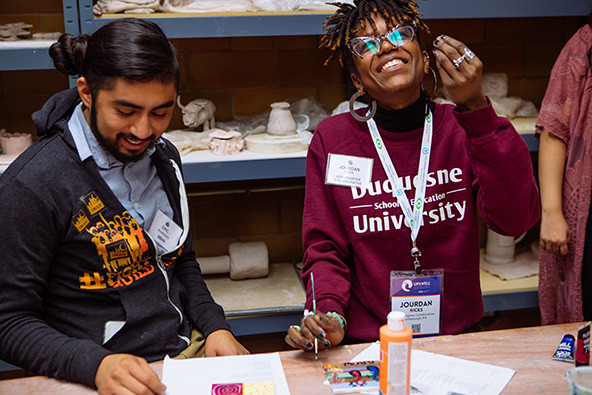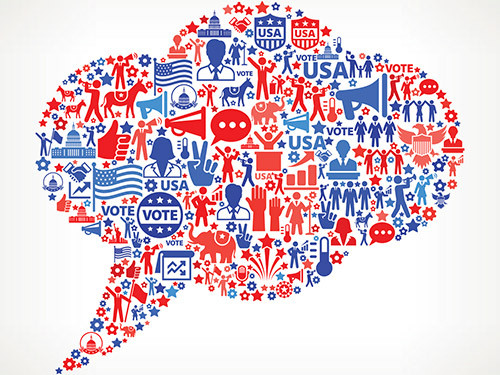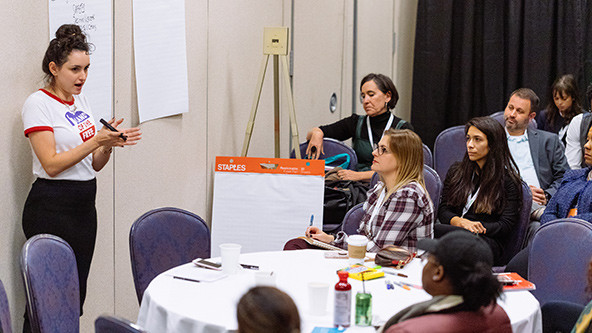 Representatives from Inner-City Muslim Action Network (left) and Morningstar Collaborative (right) discuss social innovation in the Chicago area during an Upswell 2019 tour, part of a national summit led by Independent Sector. (Photo by Erin Yasmeen for Independent Sector)
Representatives from Inner-City Muslim Action Network (left) and Morningstar Collaborative (right) discuss social innovation in the Chicago area during an Upswell 2019 tour, part of a national summit led by Independent Sector. (Photo by Erin Yasmeen for Independent Sector)
As 2021 starts, the attention of many Americans will be focused on the US presidential administration and the new Congress. They’ll be hoping for better days in the face of the COVID-19 pandemic, economic downturn, environmental crisis, and push for racial equity.
Beneath the socially distanced pomp and circumstance of Inauguration Day in Washington, DC, there will lie an important reminder that community trust and voting are the foundations for achieving positive change in American democracy. The day will highlight what’s possible when people care about their communities; cast ballots about economic, health, social, and other issues affecting their lives; and, in turn, strengthen civil society through their participation. By using their voices in 2020, Americans made history. The November 2020 elections saw nearly 160 million US citizens cast ballots, marking a 66.7 percent voter turnout rate—the highest since 1908.

This turnout reflects how communities, an array of nonprofits, and philanthropy worked each day, starting months and even years before the election, to engage US citizens on issues important to their lives and to connect those issues to public policies. Nonprofits helped translate diverse voices into power and accurate representation at the ballot box during a historically divisive time.
Nonprofits held nonpartisan voter registration and civic engagement drives, including in Black, Native, and other communities of color and in low-wealth neighborhoods. At Independent Sector, we conducted voting engagement campaigns, held webinars, and created digital toolkits for our nonprofit members and the public to share with communities nationwide.
This voting engagement and education effort was no easy task: There were serious concerns about misinformation tactics, voter suppression, and other barriers to the ballot box, especially in Black and Native communities. As the Brennan Center for Justice reports, Black and Brown voters stand in longer lines to cast ballots than white voters. There also were false accusations of voting fraud. Nonprofits stepped up and used their community trust to fill the gap by having attorneys and trained staff members answer voting rights questions from the public and issue information. Nonprofit staff members also volunteered to be poll watchers.
The historic turnout reminds us that voting is not only an occurrence that takes place every two or four years. Instead, voter turnout is the culmination of years of building community trust daily by valuing, including, and listening to people, so that they embrace the idea that casting ballots is the best legitimate path to elevating their voices and implementing positive change in the country. It’s a result of successful civic engagement and participation.
The Power of Daily Practice
We must remember that democracy is a daily practice and that the country’s 1.5 million nonprofits—including their 12 million staff members, 63 million volunteers, and numerous supporters who take pride in creating social change—are meaningfully connected to people in diverse communities across the United States. Nonprofits protect and steward the environment; provide health services, food, job training, child and elder care, and leadership and advocacy classes; and support the arts, open space, and recreation. They build social capital by bringing people together for coalitions, events, and conferences, and just by being the neighborhood gathering place that welcomes residents.
 Rochelle Keyhan, CEO of Collective Liberty, leads a discussion on addressing sex work and human trafficking at the Upswell 2019 national summit. (Photo by Erin Yasmeen for Independent Sector)
Rochelle Keyhan, CEO of Collective Liberty, leads a discussion on addressing sex work and human trafficking at the Upswell 2019 national summit. (Photo by Erin Yasmeen for Independent Sector)
They also play a critical role in everyday democracy and America’s civic infrastructure. As we have seen, nonprofits succeed in building community and national strength by encouraging people to volunteer, donate, and vote. Once a person volunteers at a nonprofit, their engagement and participation tends to deepen; they become more involved over time, later donating money, and then voting. And as one study found, if a nonprofit engages with and encourages a US citizen to vote, that person is more likely to cast a ballot compared to someone who lacks that interaction. Every day, nonprofits are listening to, serving, and working with people to ensure that respect, trust, and civic participation thrive, and this “daily renewal” of civil society is healthy for everyone in American democracy.
Building on Our Practice
While we should celebrate this historic voter turnout and the role nonprofits played in a more participatory election process, we cannot let it lull us into complacency. In 2021, those of us working at nonprofits and foundations, and on corporate giving programs, need to do even better. Although there’s no presidential election on the ballot, we must continually remember that we are part of civil society and that civil society contributes to democracy. Now is the time to strengthen that democracy by directing more private action to support the public good.
I regularly speak with nonprofit leaders around the country. In our conversations, we reflect on what the nonprofit sector is doing well and consider how we can expand our work to ensure that everyone thrives. Here are a few questions I’ve been thinking about and discussing with fellow nonprofit leaders: If the voter turnout rate in 2020 was a record 66.7 percent, what happened to the remaining 33.3 percent of eligible voters? Why did tens of millions of US citizens opt out of the election process? How can the nonprofit sector forge stronger community ties and trust across political boundaries to increase turnout and hear more voices of Americans in urban, rural, and low-wealth areas?
When I think about these questions, I often refer to my organization’s June 2020 report, “Trust in Civil Society.” It helps guide my thinking and reflections to take collaborative steps for the future. We know the public has broad trust in nonprofits, for example, but we need to do better in earning that trust in communities of color. We can do this by:
- Encouraging people to find their passion in their communities: Are residents concerned about local education, clean water, health care, the elderly, or the performing arts?
- Encouraging them to connect with a nonprofit that focuses on that passion, even if it’s virtual for now
- Encouraging them to become involved, help, volunteer, and build trust with nonprofit staff members and the public
- Encouraging people to expand how they live out their passion—to donate if they can, vote as a powerful expression of their passion to serve their community, and understand that voting is the bedrock of American democracy
We have a daunting challenge before us. The nonprofit sector needs to do better as a trusted institution in all communities in the United States. We need to improve our contributions to everyday democracy. It’s in the nation’s best interest that everyone in the social sector step fully into the daily work of democracy building, because the sector holds a sacrosanct role in catalyzing Americans to vote. Democracy can never fail the people it serves. The opportunity to do better and collaborate for greater success exists. And as someone who values how nonprofits, their staff members, volunteers, and supporters contribute to the United States, I like that prospect.
Support SSIR’s coverage of cross-sector solutions to global challenges.
Help us further the reach of innovative ideas. Donate today.
Read more stories by Dan Cardinali.

